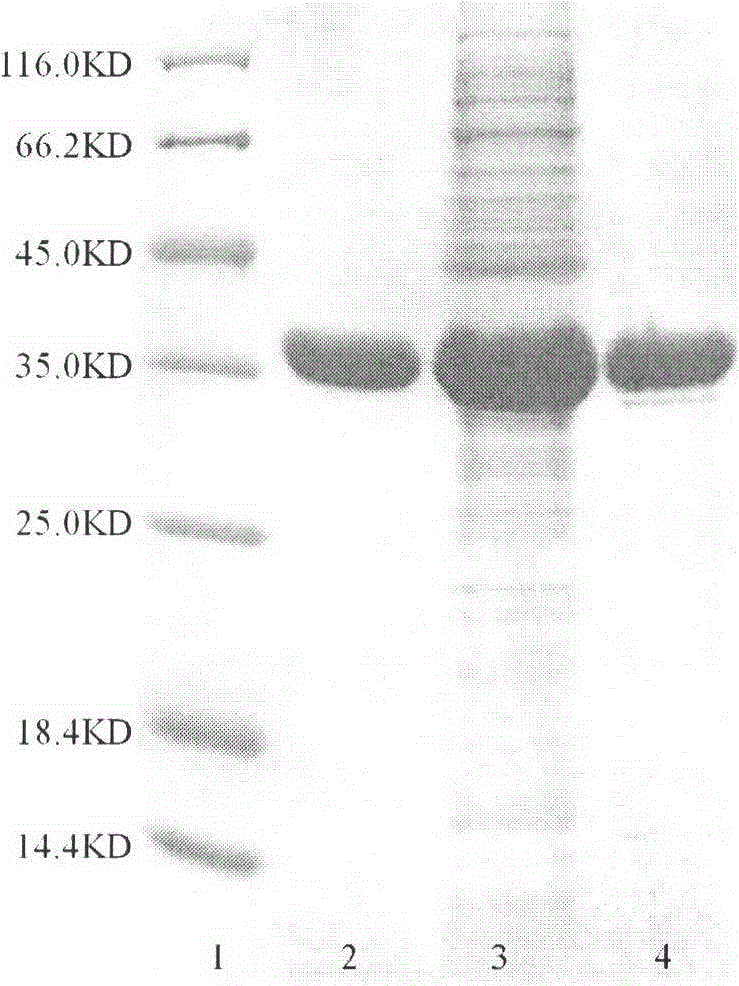New (R)-transaminase from Fusarium oxysporum and application thereof
A transaminase and amino acid technology, applied in the field of new-transaminase and its application in the production of chiral amines and unnatural amino acids, can solve problems such as transaminases that do not yet exist
- Summary
- Abstract
- Description
- Claims
- Application Information
AI Technical Summary
Problems solved by technology
Method used
Image
Examples
Embodiment 1
[0028] The preparation method of embodiment one new (R)-transaminase HFO
[0029] (1) Construction of engineering bacteria: The coding gene (SEQ NO.1) of the new (R)-transaminase HFO was amplified from the genomic DNA of Fusarium oxysporum Fo5176 by PCR technology (6×His-tag was added to the N-terminal In order to purify the target protein (HFO) with a nickel affinity column, the upstream primer is: catg CCATGG CTCACCATCATCATCATCACATGGCAACTATGGACGAGG, the downstream primer is ccc AAGCTTCTACTAGTAATCAATCTTGAAGCTGAACTC, the obtained PCR fragment was inserted into the pET28a expression vector at the Nco I / Hind III site after double digestion. The recombinant plasmid is transferred into the host bacterial cell (preferably Escherichia coli BL21 (DE3)), and the corresponding engineering strain is obtained.
[0030] (2) Expression and purification: LB medium was used to culture in a shaker at 37°C until logarithmic phase, and after cooling to 25°C, IPTG with a final concentration ...
Embodiment 2
[0032] The enzymatic property of embodiment two new (R)-transaminase HFO
[0033] The optimum pH value, optimum reaction temperature and temperature stability of the new (R)-transaminase HFO were examined.
[0034] Simple reaction formula: .
[0035] Activity assay reaction system: 1 ml of pH buffer, PLP (20 μM), (R)-1-phenylethylamine (10 mM), pyruvic acid (10 mM). The reaction was initiated by adding an appropriate amount of neo(R)-transaminase HFO and terminated with perchloric acid after half an hour of reaction. After the reaction was terminated, the amount of acetophenone generated by the reaction was determined by HPLC to determine the size of the enzyme activity.
[0036] Determination of the optimum reaction pH value: use the bioassay reaction system, the reaction temperature is 30°C, and measure at a series of different pH values (pH=5, 6, 7, 7.4, 7.8, 8, 8.4, 8.8, 9, 9.4, 9.6 , 10) The enzymatic activity of the new (R)-transaminase HFO. The buffers used in d...
Embodiment 3
[0040] Substrate spectrum and application of embodiment three new (R)-transaminase HFO
[0041] (1) Amino donor substrate spectrum of the new (R)-transaminase HFO.
[0042] Simple Reaction Formula: Amino Donor (Table 3)
[0043] Reaction conditions: 1ml of reaction system. Add pyridoxal phosphate (20μM), amino donor substrate (10mM, racemate 20mM) and pyruvate (10mM) into sodium phosphate buffer (100mM, pH7.4), mix well and add appropriate amount of HFO enzyme solution Start the reaction, react in a 30°C water bath for 30 minutes, and then terminate the reaction with 375ul of 16% perchloric acid.
[0044] Calculation of relative activity: Calculate the relative activity of each substrate by detecting the decrease of pyruvate in the reaction system. The liquid phase detection conditions of pyruvate are: Aminex HPX-87H column (Bio-Rad, USA), column temperature 45 ° C, with 5 mM H 2 SO 4 As the mobile phase, the flow rate is 0.6ml / min, and the ultraviolet absorption value ...
PUM
 Login to View More
Login to View More Abstract
Description
Claims
Application Information
 Login to View More
Login to View More - Generate Ideas
- Intellectual Property
- Life Sciences
- Materials
- Tech Scout
- Unparalleled Data Quality
- Higher Quality Content
- 60% Fewer Hallucinations
Browse by: Latest US Patents, China's latest patents, Technical Efficacy Thesaurus, Application Domain, Technology Topic, Popular Technical Reports.
© 2025 PatSnap. All rights reserved.Legal|Privacy policy|Modern Slavery Act Transparency Statement|Sitemap|About US| Contact US: help@patsnap.com



